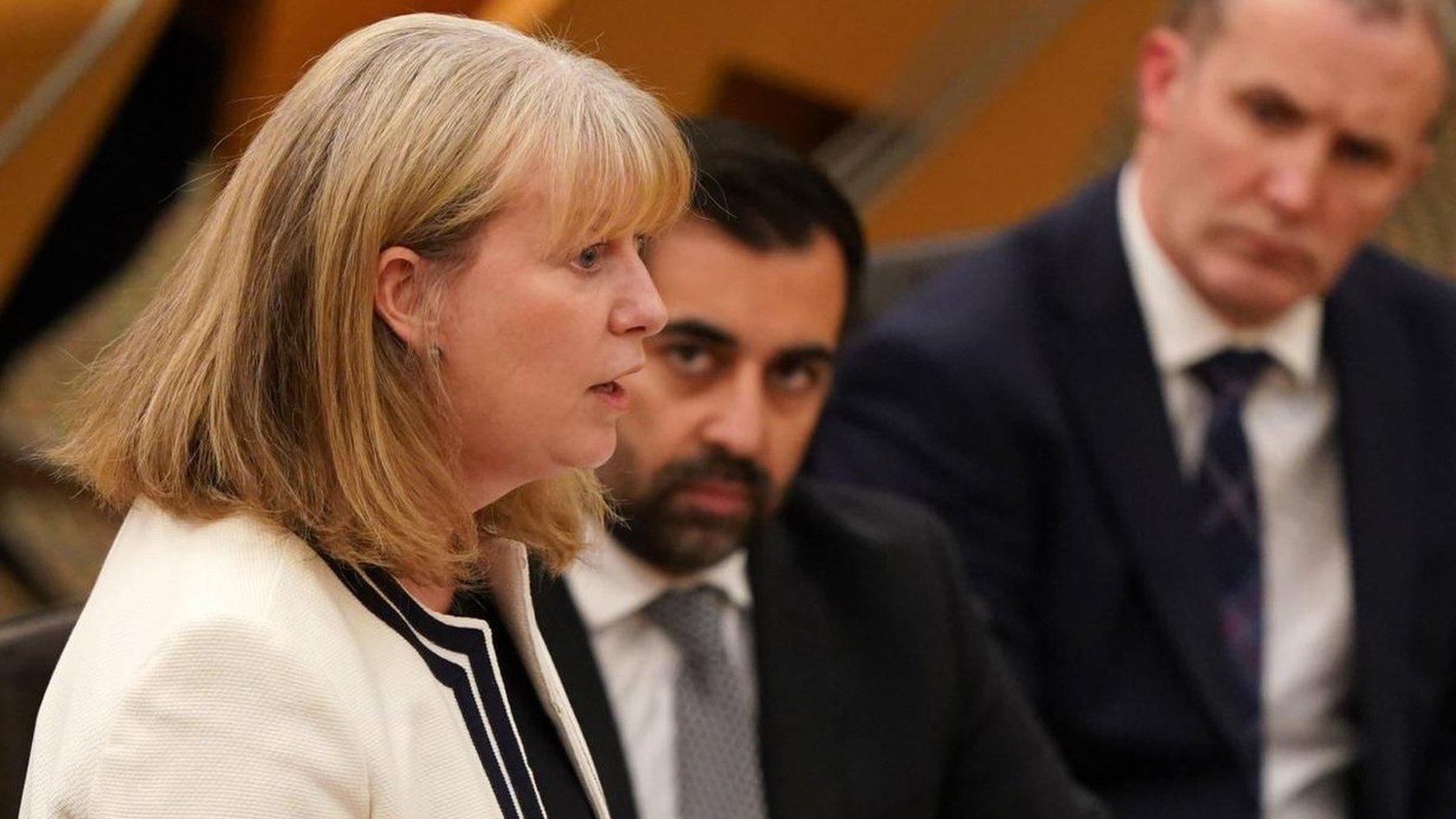Scottish income tax 2024-25 - What might you be paying?
- Published

The Scottish government's Budget Statement, external has created a new tax band, meaning Scotland now has six different income tax rates.
Deputy First Minister Shona Robison, who is also Scotland's finance secretary, told Holyrood that the new "advanced" band, with a tax rate of 45%, would apply to those earning between £75,000 and £125,140.
Ms Robison said the starter, basic and intermediate threshold would rise with inflation but the higher rate (43%) would still kick in at £43,662, the same as last year.
Based on these changes, tax consultant Deloitte has put together examples spanning different salaries.
The lower earner
£15,000 salary
If you earn a salary of £15,000 in 2024-25 and have no other income, the personal allowance of £12,570 will be deducted and £2,430 will be taxable.
If you are resident in Scotland, your income tax calculation will be as follows:
Starter rate - £2,306 at 19% = £438.14
Scottish basic rate - £124 at 20% = £24.80
Total tax = £462.94
This is a reduction in income tax of £1.44 compared to 2023-24 due to the inflationary increase to the starter rate band.
If you earned the amount but were not resident in Scotland the full £2,430 would be taxable at 20% (UK basic rate) producing an income tax bill of £486. Therefore, you would pay £23.06 less as a resident of Scotland.
The medium to higher earners
£33,000 salary
If you earn a salary of £33,000 in 2024-25 and have no other income, the personal allowance of £12,570 will be deducted and £20,430 will be taxable.
If you are resident in Scotland, your income tax will be as follows:
Starter rate - £2,306 at 19% = £438.14
Scottish basic rate - £11,685 at 20% = £2,337.00
Intermediate rate - £6,439 at 21% = £1,352.19
Total tax = £4,127.33
This is a reduction in income tax of £10.17 compared to 2023-24 due to the inflationary increases to the starter rate and basic rate bands.
If you are resident elsewhere in the UK, the full £20,430 will be taxable at 20%, giving an income tax liability of £4,086.00.
A Scottish resident would pay an additional £41.33 in income tax compared with living elsewhere in the UK.
£50,000 salary
If you earn a salary of £50,000 in 2024-25 and have no other income, the personal allowance of £12,570 will be deducted and £37,430 will be taxable.
If you are resident in Scotland, your income tax will be as follows:
Starter rate - £2,306 at 19% = £438.14
Scottish basic rate - £11,685 at 20% = £2,337.00
Intermediate rate - £17,101 at 21% = £3,591.21
Scottish higher rate - £6,338 at 42% = £2,661.96
Total tax = £9,028.31
This is a reduction in income tax of £10.17 compared to 2023-24 due to the inflationary increases to the starter rate and basic rate band.
If you are resident elsewhere in the UK, the full £37,430 will be taxable at 20%, giving an income tax liability of £7,486.00.
A Scottish resident would pay an additional £1,542.31 in income tax compared with living elsewhere in the UK.
This may feel particularly acute for employees living in Scotland with earnings between £43,662 and £50,270 who have an effective marginal tax rate of 52% once national insurance is taken into account, compared to 30% in the rest of the UK.
The higher earners
£110,000 salary
If you earn a salary of £110,000 in 2024-25 and have no other income, you are entitled to a reduced personal allowance of £7,570 because your income exceeds £100,000. Your taxable income is therefore £102,430.
If you are a resident in Scotland, your income tax breaks down is as follows:
Starter rate - £2,306 at 19% = £438.14
Scottish basic rate - £11,685 at 20% = £2,337.00
Intermediate rate - £17,101 at 21% = £3,591.21
Scottish higher rate - £31,338 at 42% = £13,161.96
Scottish advanced rate - £40,000 at 45% = £18,000.00
Total tax = £37,528.31
This is an increase in income tax of £1,189.83 compared to 2023-24 due to the new advanced rate for income exceeding £75,000, less some small reductions in tax due to the inflationary increases to the starter rate and basic rate bands.
Although the highest headline rate at this income level is the new advanced rate of 45%, the marginal rate of income tax for incomes between £100,000 and £125,140 is 67.5% (69.5% including national insurance) due to the effects of the tapering of the personal allowance.
If you are a resident elsewhere in the UK, on this salary you will pay £33,432.00 in tax - £4,096.31 less than north of the border.
£200,000 salary
If you earn a salary of £200,000 in 2024-25 and have no other income, you are not entitled to a personal allowance because your income exceeds £125,140. The taxable income is therefore £200,000.
If you are a resident in Scotland, your income tax breaks down is as follows:
Starter rate - £2,306 at 19% = £438.14
Scottish basic rate - £11,685 at 20% = £2,337.00
Intermediate rate - £17,101 at 21% = £3,591.21
Scottish higher rate - £31,338 at 42% = £13,161.96
Scottish advanced rate - £62,710 at 45% = £28,219.50
Top rate - £74,860 at 48% = £35,932.80
Total tax = £83,680.61
This is an increase in income tax of £2,619.73 compared to 2023-24 due to the new advanced rate of 45% for income between £75,000 and £125,140 together with the increase in the top rate to 48% for income above that level. There are also small reductions in tax in the lower bands due to inflationary adjustments.
If you are a resident elsewhere in the UK, on this salary you will pay £76,203.00 in tax - £7,477.61 less than north of the border.
Analysis
Garry Tetley, tax partner at Deloitte, said: "As with households north of the border, the costs of running the country continue to rise.
"The Finance Secretary noted that the lack of economic growth means that tax revenues will not keep pace with planned expenditure. As such, options for the Scottish government are limited.
"The Scottish Fiscal Commission estimate that today's announcements to introduce a new 45% rate, together with an increase in the top rate to 48%, will raise an additional £82m in 2024-25.
"This is in addition to an extra £307m through the freezing of the higher rate threshold. The additional tax for higher earners living in Scotland is growing in significance.
"The balance between efficient tax collection and attracting talent becomes ever more challenging.
"The Scottish higher rate threshold remains at £43,662 for a fourth year running, which is still significantly lower than the UK higher rate threshold of £50,270 which has been frozen until 2027/28.
"Employees earning between these thresholds also pay 10% national insurance, which results in a combined marginal tax rate of 52% in this income bracket for those living in Scotland.
"Lower earners in Scotland continue to pay less tax than those in the rest of the UK; the break-even point for 2024-25 is £28,867.
"The maximum income tax savings for lower earners from the inflationary increases to the lower rate bands is £10.17 compared to 2023-24.
"The Scottish government's devolved powers for personal taxes are limited to setting the bands and rates of income tax for non-savings non-dividend income, such as salaries, profits and pensions.
"Income tax on savings and dividend income, capital gains tax and national insurance are all set by the Westminster government.
"The nil-rate band for dividends will be halved from £1,000 to £500 from 6 April 2024. Similarly, the capital gains annual exemption will be halved from £6,000 to £3,000 from the same date.
"National Insurance will be lower in 2024-25 compared to 2023-24 for all workers on both sides of the border.
"For employees, the main rate is reducing from 12% to 10% from 6 January 2024. There will also be reductions for the self-employed from 6 April 2024. They will no longer be required to pay Class 2 national insurance and they will have a cut in the main rate of Class 4 national insurance from 9% to 8%."

- Published19 December 2023

- Published19 December 2023
